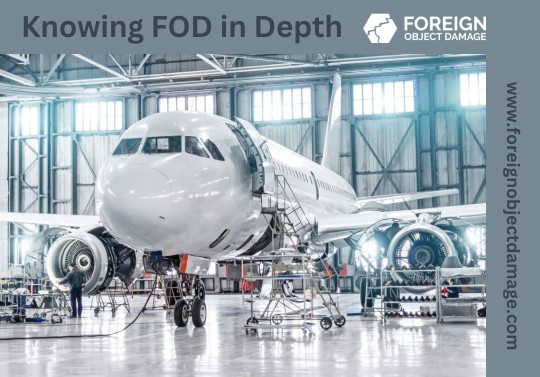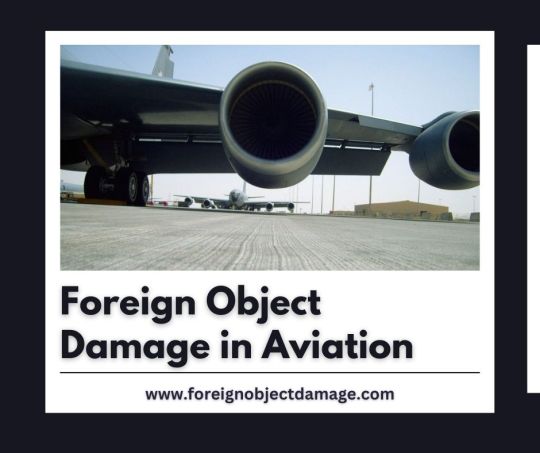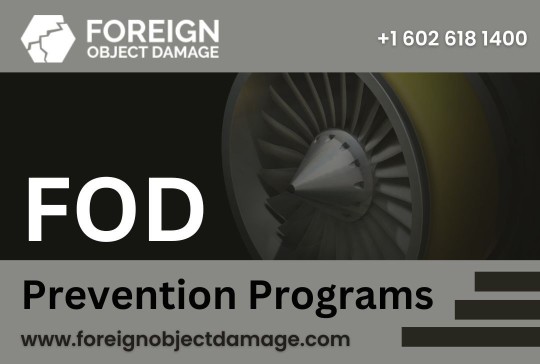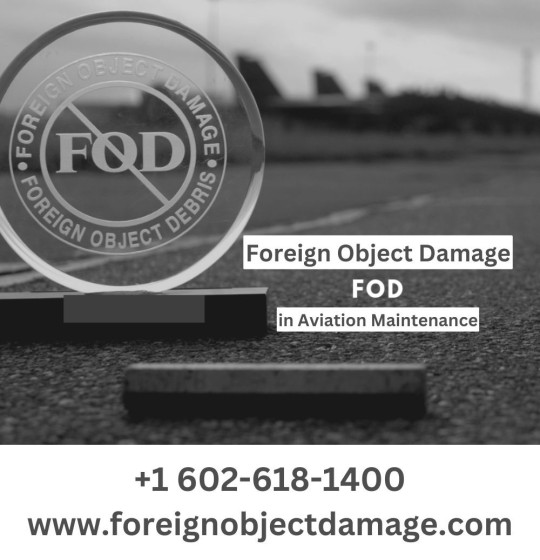Don't wanna be here? Send us removal request.
Text
The Best Way to Avoid Costs and Liability: Implementing a Foreign Object Damage Prevention Program

Introduction:
Foreign Object Damage (FOD) can lead to significant costs, liability, and safety risks in various industries, including aviation, manufacturing, and construction. FOD refers to any object, debris, or substance that should not be present in a specific area, such as aircraft runways, manufacturing facilities, or construction sites. To mitigate the adverse effects of FOD, it is crucial for organizations to establish a robust Foreign Object Damage Prevention Program. The importance of implementing such a program and discussing the best practices for avoiding costs and liability associated with FOD.
Understanding the Costs and Liability of FOD:
Foreign Object Damage can result in severe consequences, both in terms of financial expenses and potential legal implications. The costs associated with FOD can include repair or replacement of damaged equipment, delays in production or operations, additional inspection procedures, and even accidents or injuries. Moreover, organizations can face liability claims from affected parties, leading to lawsuits, damaged reputation, and potential regulatory penalties. Therefore, preventing FOD is not just a matter of operational efficiency but also a critical aspect of risk management and compliance.
Benefits of a Foreign Object Damage Prevention Program:
Implementing a Foreign Object Damage Prevention Program offers several significant advantages to organizations. These include:
Enhanced Safety: By implementing proactive measures to prevent FOD, organizations create a safer environment for employees, customers, and other stakeholders. Minimizing the presence of foreign objects reduces the risk of accidents, injuries, and equipment malfunctions, thereby prioritizing safety as a core value.
Cost Savings: The costs associated with FOD can be substantial, ranging from minor repairs to catastrophic accidents. By preventing FOD incidents, organizations can significantly reduce expenses related to equipment repair, downtime, insurance claims, and legal disputes. Investing in prevention is often more cost-effective than dealing with the aftermath of FOD events.
Operational Efficiency: FOD incidents can cause delays in production, maintenance, or service delivery. By implementing a prevention program, organizations can optimize their operational efficiency by minimizing disruptions, improving productivity, and maintaining a smooth workflow.
Regulatory Compliance: Many industries have regulations and standards related to FOD prevention. Implementing a program ensures that organizations comply with these requirements, avoiding penalties and potential legal consequences. Demonstrating a commitment to FOD prevention can also enhance relationships with regulatory bodies and improve industry reputation.
Key Elements of an Effective Foreign Object Damage Prevention Program:
Training and Education: Conduct comprehensive training programs to educate employees about FOD hazards, prevention techniques, and the importance of vigilance. Ensure that all personnel, from top management to frontline workers, are aware of their responsibilities in preventing FOD.
Risk Assessment and Mitigation: Perform regular risk assessments to identify areas and processes vulnerable to FOD. Develop mitigation strategies, such as installing protective barriers, implementing strict cleaning protocols, and establishing clear procedures for FOD removal.
Tools and Equipment Control: Establish robust control measures for tools and equipment used in critical areas. Implement procedures for tracking, inspecting, and maintaining tools to ensure they are free from foreign objects. Employ tool accountability systems and strict control over access to sensitive areas.
Housekeeping and Maintenance: Maintain a clean and organized work environment to minimize the presence of foreign objects. Implement regular inspections, cleaning schedules, and housekeeping protocols. Conduct routine maintenance of machinery and equipment to prevent FOD incidents caused by equipment failure.
Reporting and Investigation: Implement a system for reporting and documenting FOD incidents. Encourage employees to report potential hazards or near-miss events. Investigate incidents promptly to determine root causes and implement corrective actions to prevent recurrence.
Continuous Improvement: Regularly review and update the FOD prevention program based on lessons learned, industry best practices, and emerging technologies. Encourage feedback from employees and stakeholders to identify areas for improvement.
Conclusion:
The implementation of a Foreign Object Damage Prevention Program is essential for organizations aiming to minimize costs, liability, and safety risks associated with FOD. By prioritizing prevention through training, risk assessment, equipment control, maintenance, and continuous improvement, organizations can create safer work environments, reduce operational disruptions, and safeguard their reputation. Investing in a comprehensive FOD prevention program is a proactive approach that ensures compliance with regulations, protects the bottom line, and fosters a culture of safety and excellence.
0 notes
Text
Everything that you should know about Foreign Object Damage

Foreign Object Damage (FOD) is a serious concern for the aviation industry, as it can cause significant damage to aircraft, airports, and related infrastructure. FOD can be caused by any object, substance or debris that is not supposed to be in a particular area, and it can range from small rocks and pebbles to larger items such as tools and equipment.
Causes of Foreign Object Damage:
Foreign Object Damage can be caused by a variety of factors, including natural causes such as wind, rain, and hail, as well as human factors such as improper maintenance procedures, inadequate training, and poor housekeeping practices. Some of the most common causes of FOD include:
Wildlife: Birds, deer, rodents, and other wildlife can cause FOD by leaving behind feces, nests, and debris.
Weather: Strong winds, heavy rain, and hail can cause debris to accumulate on runways and taxiways.
Maintenance and Construction: Tools, equipment, and debris left behind during maintenance or construction activities can cause Foreign Object Damage.
Poor Housekeeping: Litter, trash, and debris left on the runway or taxiway can cause FOD.
Human Error: Improperly secured cargo, loose screws or bolts, and other mistakes can cause FOD.
Effects of Foreign Object Damage:
The effects of Foreign Object Damage can range from minor to catastrophic, depending on the size and location of the object or debris. Some of the common effects of FOD include:
Engine Damage: FOD can cause damage to aircraft engines, resulting in reduced efficiency or complete engine failure.
Tire Damage: Runway debris can cause damage to aircraft tires, leading to punctures, blowouts, and other tire-related problems.
Structural Damage: Debris can cause structural damage to aircraft, including damage to wings, fuselage, and other critical components.
Safety Concerns: Foreign Object Damage can create safety hazards for pilots, passengers, and ground crew.
Flight Delays: FOD can cause flight delays or cancellations due to aircraft damage or debris removal.
Prevention Methods:
Preventing FOD is critical to ensuring safe and efficient aviation operations. There are several prevention methods that can be used to reduce the risk of Foreign Object Damage:
Regular Inspections: Regular inspections of runways, taxiways, and other airport areas can help identify and remove potential FOD hazards.
Housekeeping: Maintaining a clean and tidy work environment can help prevent FOD by reducing the amount of debris and trash on the runway or taxiway.
Training: Proper training of ground crew, maintenance personnel, and other airport staff can help prevent FOD by ensuring that they understand the risks and are aware of proper procedures.
Control Measures: Installing barriers, screens, and other control measures can help prevent FOD by keeping wildlife, debris, and other hazards away from airport operations areas.
Reporting: Encouraging pilots, ground crew, and other personnel to report potential Foreign Object Damage hazards can help prevent future incidents.
Impact on the Aviation Industry:
Foreign Object Damage can have a significant impact on the aviation industry, including:
Financial Costs: FOD can result in significant financial costs to airlines, airports, and other aviation industry stakeholders.
Safety Concerns: FOD can create safety concerns for pilots, passengers, and ground crew.
Delays and Cancellations: FOD can cause flight delays and cancellations due to aircraft damage or debris removal.
Reputation: FOD incidents can damage the reputation of airlines and airports, leading to decreased customer confidence and reduced business.
0 notes
Text
What We Need To Know About FOD Products

Foreign Object Damage (FOD) is a significant concern in many industries, particularly in aviation and manufacturing. FOD can be defined as any object, substance or debris that is found in an area where it is not supposed to be, and it can cause serious damage to equipment, machines or even people. In this blog, we will discuss the basics of Foreign Object Damage and what you need to know about FOD products.
FOD products are designed to prevent foreign objects from entering critical areas, where they can cause damage. These products come in various shapes and sizes, depending on the application, and they are made from different materials, such as metal, plastic, or rubber. Here are some of the most common FOD products:
FOD Guards: FOD guards are physical barriers that prevent foreign objects from entering a specific area. These guards can be installed around machinery, engines, or other critical equipment to protect them from damage caused by foreign objects.
FOD Mats: FOD mats are designed to trap and contain small objects that may fall off during maintenance or manufacturing processes. These mats are made from materials that are easy to clean and maintain, and they can be used in a variety of settings.
FOD Wipes: FOD wipes are used to clean surfaces and remove any small objects that may be present. These wipes are made from materials that are non-abrasive and safe to use on delicate surfaces.
FOD Detectors: FOD detectors are electronic devices that can detect the presence of foreign objects. These devices use various technologies, such as X-rays or metal detectors, to identify any foreign objects that may be present.
FOD Bags: FOD bags are used to store and transport small parts and tools. These bags are made from materials that are durable and can withstand the rigors of transportation and storage.
In conclusion, FOD is a serious concern in many industries, and it can cause significant damage to equipment, machines or even people. FOD products are designed to prevent foreign objects from entering critical areas, where they can cause damage. By using FOD products, you can reduce the risk of FOD-related incidents and ensure the safety and reliability of your equipment and machinery.
#FOD Products#FOD Product#Foreign Object Damage Products#Foreign Object Damage Product#FOD Damage Products#FOD Damage Product#Foreign Object Damage#FOD
0 notes
Text
All About Preventive Methods of Foreign Object Damage

FOD is an issue of quality and security and it may lead to a fatal incident. For controlling and eliminating FOD, foreign object damage prevention programs and products are used. The first and foremost need is to make them more effective and this can be done by adding the crucial aspects of training, inspection, maintenance, and communication to the preventive programs. Besides this, the employees need to follow the rule of clean as you go. Other ways include de-cluttering the workplace, involving the upper management, and raising funds for FOD by enhancing awareness and understanding among the public.
#Foreign object damage prevention programs#Foreign object damage prevention#Foreign object damage programs#Foreign object damage#FOD prevention programs#FOD prevention#FOD programs#FOD Damage prevention programs#FOD Damage prevention#FOD Damage programs
0 notes
Text
The Dangers of Foreign Object Damage and How to Prevent it

Foreign Object Damage (FOD) is a very real threat to aircrafts and vehicles that can lead to serious crashes or malfunctions. FOD occurs when debris like rocks, ice, tools, or even birds finds its way into an engine during operation - this debris can cause significant engine damage. Prevention of Foreign Object Damage is absolutely critical in order to protect passenger safety and equipment. To help prevent FOD, it's important to stay engaged with maintenance staff and keep an eye out for any debris while on the ground, as well as practice strict cleanliness protocols when servicing equipment. Unfortunately, FOD cannot be avoided entirely but it's critical to ensure this risk is managed in order to mitigate accidents due to Foreign Object Damage.
0 notes
Text
Understanding Foreign Object Damage in Depth

Aviation and aerospace industries are dependent on the smooth running of equipment. Any malfunction can cause a fatal incident. Foreign object damage is one such type of malfunction and can be caused by anything from birds to runway debris. Though prevention is the only key to void FOD, some tips can be followed for controlling FOD such as keeping track of aircraft & equipment, use of proper safety gear, following the safety guidelines, keeping the area clean, preparing for emergencies, damage assessment at regularly, and avoiding the contact with aircraft. Following all these things will help in preventing and controlling FOD up to a great extent.
0 notes
Text
The other side of FOD products

Any foreign object that can harm the working of any aircraft comes into FOD products. The removal of these products carefully is very important as they can again become debris. But there is one more way by which they can harm us by going into our bodies. The ingestion of these products can lead to critical situations that can be sometimes life-threatening also. For removing these foreign objects from the human body, equipment like suction devices, bronchoscopes, endoscopes, magnets, retractors, and in some cases surgical invention is also required. By there are some products that can be removed from the human body naturally. They don’t require any removal equipment. To safeguard from foreign objects, they should be kept away from reach or destroyed if not of any use.
#FOD Products#Foreign Object Damage Products#FOD Damage Products#FOD Product#Foreign Object Damage Product#FOD Damage Product#Foreign Object Damage
0 notes
Text
Why Foreign Object Damage Prevention Programs are Important

Foreign Object Damage Prevention Programs are essential to ensure the safety of those in a space of any kind. Foreign Objects, such as tools dropped by workers, can easily cause catastrophic events in aircrafts and other transportation vehicles if they are sucked into engines or fall onto the runway. Foreign Object Damage Prevention Programs help create a culture of zero-tolerance for foreign object debris that can affect an operation's safety, efficiency, and productivity. These programs help to train people on proper Foreign Object Damage prevention techniques, and create a well-structured system to quickly identify and remove FOD from potentially dangerous places. It is clear that Foreign Object Damage Prevention Programs are vital for the safety and efficiency of many operations.
#Foreign Object Damage Prevention Programs#Foreign Object Damage Prevention#Foreign Object Damage Programs#FOD Prevention Programs#FOD Programs#FOD Prevention#FOD Damage Prevention Programs#FOD Damage Programs#FOD Damage Prevention#Foreign Object Damage
0 notes
Text
What We Need To Know About foreign object damage Products

FOD Foreign Object Damage Products are essential for mitigating the risk of FOD in operations that involve aviation, transportation and construction industries. FOD prevention products play a critical role in ensuring that FOD hazards are prevented or reduced to an acceptable level. FOD detection systems are also available, which include FOD Walkers and FOD Alerts, both of which assist in providing early warnings about potential FOD risks. FOD products such as vacuum sweeping and magnet cleaning are available for removing FOD from operational sites and equipment. Additionally, FOD Control Systems can be implemented to monitor for FOD incidents and train personnel on identifying potential FOD threats. All of these FOD prevention measures combined help reduce the potential costly damages due to foreign objects that can disrupt operations.
#FOD Products#Foreign Object Damage Products#Foreign Object Damage#FOD Product#Foreign Object Damage Product#FOD Damage Products#FOD
0 notes
Text
Understanding All Aspects of Foreign Object Damage

Any object found at an inappropriate location that has the potential to cause damage to aircraft and equipment is FOD foreign object damage. Many factors affecting regulating the FOD are an organized housekeeping system, improper conduct at the workspace, and inadequate technology. This is the most widespread issue in the aviation sector and this can only be eliminated by using & implementing proper preventive programs and products. It is among those issues that can cause aircraft damage and lead to unintended consequences. FOD comprises many objects like run-up pads, access roads, cargo aprons, boulders, catering supplies, and loose hardware.
#FOD Foreign Object Damage#Foreign Object Damage#FOD Damage#FODForeign Object Damage FOD#Foreign Object Damage FOD
0 notes
Text
Knowing FOD Damage In Depth

FOD or foreign object damage in aviation includes any object that has been found in any inappropriate location and that can harm a person due to being at that location. The classification of FOD materials includes pavement fragments, building materials, baggage items, sand, catering supplies, and loose hardware. The possible places where the FOD can be found are the runway, taxiway, gates, and run-up pads. This FOD can be of three types runway FOD, maintenance FOD, and taxiway FOD. It can damage aircraft engines if ingested, cut the aircraft tires, impact the operation of aircraft, and injure individuals. FOD must be controlled to avoid further mis happenings.
#foreign object damage in aviation#foreign object damage aviation#foreign object damage#FOD damage in aviation#FOD damage aviation#FOD in aviation#FOD aviation#FOD
1 note
·
View note
Text
Preventing Foreign Object Damage is a Priority

FOD has now become an important quality control and safety concept in any aerospace and aviation sector. Unlike in previous times, now Foreign Object Damage preventive programs and tools have been used to ensure any mishappenings or damage due to FOD. FOD prevention program includes the use of equipment for controlling Foreign Object Damage along with the use of FOD detection systems like using radar or camera that can scan runaways for the presence of wildlife or debris. Besides this, it also includes airfield sweepers, use of disposal cans, tools & parts kitting for keeping track of small objects, aircraft wheel covers, and many more.
#Foreign Object Damage Prevention Program#Foreign Object Damage Prevention#Foreign Object Damage Program#Foreign Object Damage#FOD Prevention Program
0 notes
Text
Understanding foreign object damage in depth

FOD or foreign object damage in aviation is any object whether alive or not, found disproportionately at any location in the airport environment that can damage the aircraft along with harming the people in airplane or helicopter as well as at the airport. The presence of FOD is very concerning and now many FOD prevention programs and products are available to avoid inevitable circumstances. All the FOD programs have four main aspects which include awareness training, inspection, maintenance, and coordination. Every FOD has its way of preventing runway FOD relates to objects falling from aircraft, or any broken equipment, Taxiway FOD relates to the presence of small objects, and Maintenance FOD relates to tools, small parts, or materials.
0 notes
Text
Preventing FOD at Airports

The prevention method for FOD starts with a good and effective foreign object damage program with both active and passive measures for the prevention of FOD. Though there can be any type of FOD, the most damaging form of FOD is Runway FOD, Maintenance FOD, and Taxiway FOD. There are a few points that are required to be kept in mind along with implementing prevention programs. These include holding employees’ training sessions for a better understanding of FOD, conducting regular inspections, and employing FOD maintenance systems like sweeping, FOD containers, netting & fencing, rumble strips, and magnetic bars. All of these will help in getting more success in controlling FOD.
0 notes
Text
How to Implement an Effective FOD Prevention Program

Foreign object damage (FOD) is a severe threat to the safe operation of aircraft. FOD can occur when objects are ingested into engines or other systems, damaging critical components. Even small pieces of debris can cause significant damage, and the costs of repairs can be very high. FOD prevention programs are essential for Aerospace companies, as they help to reduce the risk of FOD occurring. FOD prevention programs typically involve measures such as regular cleaning and inspection of aircraft, as well as the use of FOD detection devices. These programs help to reduce the likelihood of FOD occurring, and they can also save Aerospace companies significant amounts of money in repairs and downtime.
0 notes
Text
Knowing FOD in brief

The important safety and quality control concepts in aviation and aerospace sectors are FOD; foreign object damage. The damage caused by foreign debris affects the functionality, quality, and economic value of any aircraft or airplane. The FOD can be tools, scrap metals, building materials, trash, food wrappers, nuts, rags, gloves, and many more. All these if located in inappropriate places can cause havoc. To control FOD, many foreign object damage prevention programs and products have been introduced. The programs mainly focus on four critical areas of training, maintenance, coordination, and inspection. These programs define the procedures that are required for eliminating FOD successfully.
#Foreign Object Damage Prevention Program#Foreign Object Damage Prevention#Foreign Object Damage Program#Foreign Object Damage
0 notes
Text
Foreign Object Damage And Its Impact

FOD is a big issue in the aviation maintenance industry that reduces the safety level of an aircraft. In fact for controlling foreign object damage in aviation maintenance, the implementation of regular and precise methods is required. FOD can cause destruction and severity to the aircraft to such an extent that it leads to engine failure and raised the risk of loss of human life. Nowadays, many incidents of FOD have occurred due to some reasons and this has also led to the survey of aviation safety in the aviation industry. The result of the survey has indicated that FOD is the most potent cause of catastrophic aviation failure.
#Foreign Object Damage in Aviation#Foreign Object Damage#Foreign Object Damage in Aviation Maintenance#FOD in Aviation Maintenance
0 notes